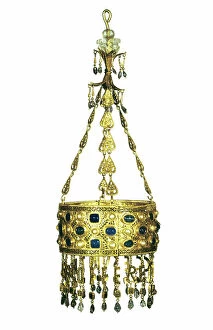Visigothic Art Collection
Visigothic art, also known as the art of the Visigoths
All Professionally Made to Order for Quick Shipping
Visigothic art, also known as the art of the Visigoths, refers to the artistic style and cultural expressions of the Visigothic Kingdom in Spain during the early Middle Ages. This unique form of art emerged after the fall of the Roman Empire and blended elements from various cultures such as Roman, Byzantine, and Germanic. Characterized by intricate metalwork, colorful mosaics, and elaborate stone carvings, Visigothic art reflected a fusion of different artistic traditions. The Visigoths were skilled craftsmen who excelled in creating ornate jewelry, decorative objects, and architectural elements that showcased their creativity and craftsmanship. One of the most iconic examples is found in churches such as San Juan de Baños in Palencia and Santa Comba de Bande in Ourense. These churches feature stunning frescoes depicting biblical scenes, geometric patterns, and floral motifs that highlight the sophistication and skill of Visigothic artists. Despite facing political instability and religious conflicts during their rule in Spain, the Visigoths left behind a rich legacy of artistic achievements that continue to inspire scholars and enthusiasts today. Their art serves as a testament to their cultural identity and creative ingenuity during a tumultuous period in European history.












